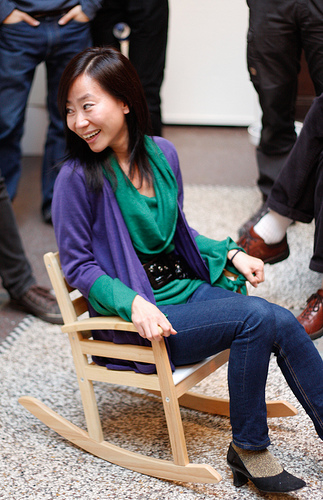To keep track of my work process as well as the project outcomes i will use my blog to take notes on processes, challenges, likes/dislikes etc. It is mainly for my own personal record but please feel free to comment!
Process
1. Coming up with the initial topic of ‘Guerilla free time – how can technology, which has been designed to heighten our efficiency and productivity facilitate break time, helpful laziness, etc.’
2. Brainstorm, Brainstorm, Brainstorm-We spent a day developing an idea around this concept. The ideas built on top of each other and progressed. During this time we always referred back to the brief to ensure we were meeting the key requirements. The idea we decided on was:
‘ROCK IS THE NEW SWIVEL”
The swivel chair is a classic ‘efficiency technology’ that has left aching backs and stress in its wake. In this prototype, we seek to introduce a powerful antidote into the domain dominated by the swivel. We emphasize how ‘rock’, an interaction that all but disappeared from the modern ‘sitting’ context, can be a mantra to soothe frayed nerves, and at the same time serve up a widely appreciated need, thanks to networked digital technology. Via our prototype, the everyday mundane act of fetching coffee during a hectic schedule is transformed into an act of relaxation, a forced ‘quiet time’ that encourages you to use every coffee drinking opportunity to take a break, listen to some music, and simply chill. 🙂
3.When we reached a point where we were excited about the idea and thought it fitted the brief we started to think about the technicalities of it….How would it work?What technology would we use?would it be engaging for the user? What existing physical products would be need?
4. Think about……DESIGN, TECHNOLOGY, PEOPLE
5. We collected, bought and ordered everything we would need for the project
6. Created Prototype (see stages below)
-get accelerometer detecting motion and creating a reading
-Using the detection of motion to trigger switching something on
-Built relay into plug board to allow for turning on the coffee maker
-Test turning on a desk lamp when the accelerometer detects motion (with the relay in place)
-This worked so replaced the lamp with the coffee maker
-Make the two Arduino’s communicate wireless with the zigbee
-Incorporate music as an output when the accelerometer detects motion
-Work out timings for turning system on/off, turning music on/off etc.
-Connect electronics/sensors/Arduino to the rocking chair and coffee maker
-test the the system with ourselves
-refine timings in the code
-user test with others
-refine aesthetics and plan/prepare exhibition space
-Chill out and present out idea!
Challenges
- finding an idea that we were equally excited about,was do-able yet challenging enough and fitted the brief in a limited time frame.
- Creating a system that would work even if people interacted with it differently.
- Even though we only had 3 main variables within the system, numerous complexities on how someone would interact with it emerged.
- When our necessary parts we needed to progress didn’t arrive it became frustrating as we felt very unproductive.
What worked well….
- The ‘rocking chair’ gesture was very intuitive so the user would very easily know or learn what do as soon as they sat on the rocking chair and the experience began.
- The simplicity of the overall concept allowed us to created a well round experience that worked well and looked good. I think the concept of ‘Less is more’ applied to this concept and execution.
- The addition or music being played through the chair enhanced the user experience.
- The rocking chair and coffee maker looked completely un-hacked, they appeared as 2 stand alone artifacts. Only when the user interacted with them you realized that they were connected and could communicate together. They used the technology to create a little magic!
Overall i loved the whole project, my favourite part was probally seeing everything come together at the end to create not only two products that worked together but also created a whole experience for the user.




